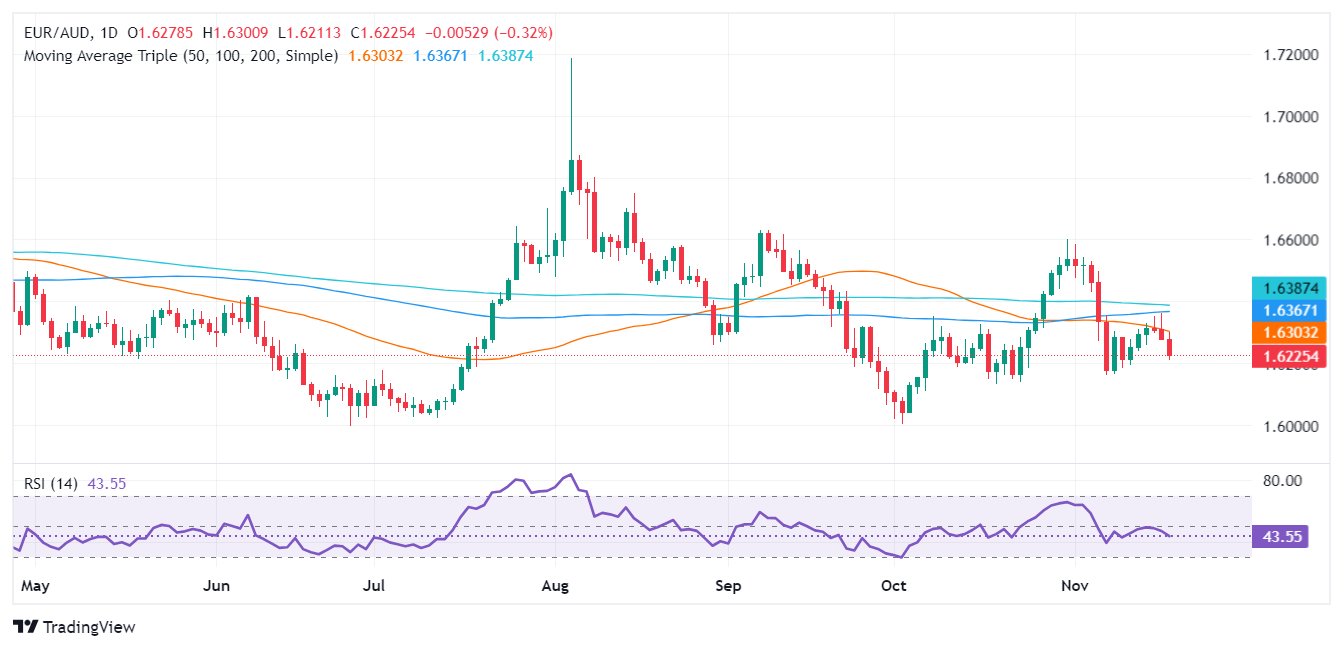EUR/AUD Price Forecast: Dips below 50-day SMA, sellers eye 1.6200
- EUR/AUD drops reacting to the latest insights from the Reserve Bank of Australia's policy discussions.
- Technical indicators show a downward trend with potential support tests at 1.6200 and October lows.
- Resistance lies at the 50-day SMA of 1.6296; a break above could challenge the 100-day and 200-day SMAs at 1.6368 and 1.6385, respectively.
On Tuesday, the EUR/AUD tumbled over 0.39% following the release of the last meeting minutes of the Reserve Bank of Australia (RBA). As Wednesday’s Asian session begins, the cross-pair trades at 1.6222, virtually unchanged.
EUR/AUD Price Forecast: Technical outlook
Technically speaking, the EUR/AUD shifted bearishly biased after clearing the 50, 100, and 200-day Simple Moving Averages (SMAs). Additionally, the successive series of lower highs and lower lows indicated the trend is downwards, and if sellers clear the November 19 low of 1.6211, a test of 1.6200 would be up next. A break below the latter will expose the October 18 low of 1.6134 before the pair drops to October’s low of 1.6005.
However, a decisive break above the 50-day SMA at 1.6296 will immediately expose 1.6300. If surpassed, buyers could regain control if they clear the 100 and 200-day SMAs, each at 1.6368 and 1.6385, respectively.
EUR/AUD Price Chart – Daily

Euro FAQs
The Euro is the currency for the 19 European Union countries that belong to the Eurozone. It is the second most heavily traded currency in the world behind the US Dollar. In 2022, it accounted for 31% of all foreign exchange transactions, with an average daily turnover of over $2.2 trillion a day. EUR/USD is the most heavily traded currency pair in the world, accounting for an estimated 30% off all transactions, followed by EUR/JPY (4%), EUR/GBP (3%) and EUR/AUD (2%).
The European Central Bank (ECB) in Frankfurt, Germany, is the reserve bank for the Eurozone. The ECB sets interest rates and manages monetary policy. The ECB’s primary mandate is to maintain price stability, which means either controlling inflation or stimulating growth. Its primary tool is the raising or lowering of interest rates. Relatively high interest rates – or the expectation of higher rates – will usually benefit the Euro and vice versa. The ECB Governing Council makes monetary policy decisions at meetings held eight times a year. Decisions are made by heads of the Eurozone national banks and six permanent members, including the President of the ECB, Christine Lagarde.
Eurozone inflation data, measured by the Harmonized Index of Consumer Prices (HICP), is an important econometric for the Euro. If inflation rises more than expected, especially if above the ECB’s 2% target, it obliges the ECB to raise interest rates to bring it back under control. Relatively high interest rates compared to its counterparts will usually benefit the Euro, as it makes the region more attractive as a place for global investors to park their money.
Data releases gauge the health of the economy and can impact on the Euro. Indicators such as GDP, Manufacturing and Services PMIs, employment, and consumer sentiment surveys can all influence the direction of the single currency. A strong economy is good for the Euro. Not only does it attract more foreign investment but it may encourage the ECB to put up interest rates, which will directly strengthen the Euro. Otherwise, if economic data is weak, the Euro is likely to fall. Economic data for the four largest economies in the euro area (Germany, France, Italy and Spain) are especially significant, as they account for 75% of the Eurozone’s economy.
Another significant data release for the Euro is the Trade Balance. This indicator measures the difference between what a country earns from its exports and what it spends on imports over a given period. If a country produces highly sought after exports then its currency will gain in value purely from the extra demand created from foreign buyers seeking to purchase these goods. Therefore, a positive net Trade Balance strengthens a currency and vice versa for a negative balance.

